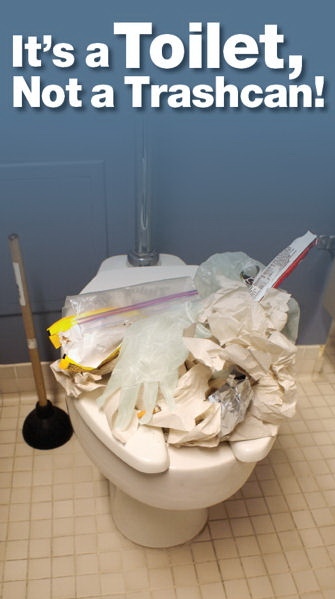Florida Water Environment Association
The State of the Flush!
Better product guidelines, marketing standards for pipe-clogging “flushables” are on the way
By Brianne Nakamura, Program Manager in the Water Science & Engineering Center at the Water Environment Federation (Alexandria, Va.).
Flushable wipes: To flush or not to flush?
While the average consumer might wash their hands of the matter without a thought, for those in the wastewater industry, the nightmares of clogged pumps and sanitary sewer overflows (SSOs) come to mind. Recently, the topic of “flushable” wipes has become front and center within the wastewater industry, as more consumers are turning to a wet wipe rather than the common dispersible toilet paper.
While flushable wipes have been on the market for years, the question of their degradability has been garnering more attention in the media and prompted state-level responses, such as the recently proposed bill in Maine requiring that products labeled “flushable” live up to their claim.
Advertising versus reality
According to the current Association of Nonwoven Fabrics Industry (INDA; Cary, N.C.) guidelines (GD3, June 2013), a “flushable” is “any product that is marketed as ‘flushable’ [that] can be flushed into the wastewater system without adversely impacting plumbing or wastewater infrastructure and operations.” Under voluntary INDA guidelines, a product must pass seven assessment tests or be clearly labeled with the “Do Not Flush” logo.
These tests include a toilet and drain-line clearance test, disintegration “slosh box” test, household pump test, settling column test, aerobic test, anaerobic test, and municipal pump test. According to INDA guidelines, if a product passes all seven tests, it should not “under normal circumstances” block toilets, drainage pipes, water conveyance, and treatment systems or become an aesthetic nuisance in surface waters. But testing and real life can have different outcomes, especially under “normal circumstances.” The U.S. Federal Trade Commission (FTC) recently announced its tentative agreement with wipe manufacturer Nice-Pak Products Inc. (Orangeburg, N.Y.), that might further define some of these issues.
Problems can’t be wiped away
For wastewater utilities, these “nondispersibles,” or anything other than human waste and toilet paper flushed down the toilet, are problematic throughout the treatment process. They cause ragging in pipes and lift stations and get caught in screens, pumps, and settling basins.
Nondispersibles wreak havoc in rainy and dry climates alike. They clog collection systems during storms and cause SSOs or, in a drought-ridden area (we’re looking at you, California), the lack of water velocity in collection systems prevents wipes from breaking down. In extreme and highly publicized cases, the accumulation of wipes and other nondispersibles can cause the formation of “fatbergs,” such as those weighing as much as 15 tons in London sewers.
Industry response to the flushables flood
Although recent media attention has increased awareness of the consequences of convenient-yet-clog-causing wipes (and other nonflushable materials), wastewater utilities throughout the country have responded with their own public education campaigns, such as “What2Flush” in California and “Don’t Flush Baby Wipes” in Maine. These initiatives, as well as the wastewater industry’s “Three P’s (Pee, Poop, and
“Toilet” Paper) standard, have been informing homeowners and renters about what’s OK to flush and to not use toilets as trash cans.
The Water Environment Federation (WEF; Alexandria, Va.) has also been involved in the initiative to improve flushability requirements and educate the public. In 2010, the WEF Collection Systems Committee formed a Flushables Task Force in response to the growing concern about wipes-related problems. The WEF House of Delegates (HOD) followed suit in 2012 to involve Member Associations with the formation of the HOD Non-Dispersible Work Group.
To create a singular message, the WEF Flushable Task Group, formed in 2014 and currently chaired by Scott Trotter, has worked on several initiatives including a 2013 billing stuffer campaign with the tagline, “It’s a Toilet, Not a Trashcan!” The group also advocated for collaborative studies conducted by the Water Environment Research Foundation (Alexandria, Va.).
More recently, the Task Group, as a representative of WEF, is collaborating with four other associations representing the water sector and the nonwoven fabrics industry: INDA, the National Association of Clean Water Agencies (Washington, D.C.), the American Public Works Association (Kansas City, Mo.), and the Canadian Water & Wastewater Association (Ottawa, Ontario). The goal is to develop a new, fourth edition of guidelines (GD4) that will influence product design and support the marketing of nonwoven products as “flushable.” The guidelines are scheduled to be released in July 2016.
In addition, the collaborative effort is behind the Product Stewardship Initiative to increase public and consumer awareness about the proper disposal of wipes. The initiative seeks to improve the labelling of both flushable and nonflushable products, as well as increase the industry’s responsibility over the downstream impacts of flushable products.
WEF has been heavily involved in both GD4 and the Product Stewardship Initiative. As the awareness of the problems of flushable wipes continue to increase, both in the media and within the wastewater industry, WEF continues to support the initiatives of the Flushables Task Force. While we can’t stop consumers from flushing things down their toilets, we can stem the tide with better education and incentives for corporate responsibility.
Brianne Nakamura is a Program Manager in the Water Science & Engineering Center at the Water Environment Federation (Alexandria, Va.). She is the staff liaison for the Collection System Committee and can be contacted at bnakamura@wef.org.

Photo caption: The WEF Flushable Task Group, formed in 2014 and currently chaired by Scott Trotter, has worked on several initiatives for better public awareness about nondispersibles, including this 2013 billing stuffer campaign.
